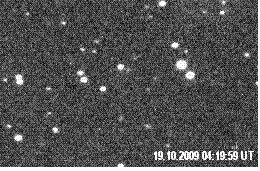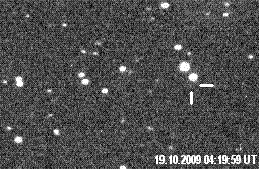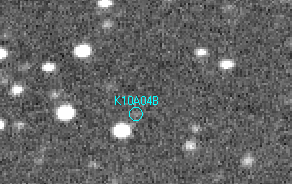Remote observation of asteroids
Internet and new ways in observations
A new era has started in astronomy when Galileo Galilei turned his telescope to the sky four centuries ago. As time goes by astronomers used more and more sophisticated instruments for observations - bigger and better telescopes, later they began to use advatnages of photography. Then first spacecrafts offered us images of the Moon and nearby planets 50 years ago. Finally came the Hubble Space Telescope, Spitzer and WISE observatories provided us deeper insight to the heavenly bodies. But the real revolution in astronomy imaginery came along with CCD cameras and broad usage of internet. The high power of this two instruments enabled amateurs with medium setup to observe objects, which were few years ago privilige for only the biggest observatories and space telesccopes. Remote observations
CCD camera allowed to amaterur astronomers to do real science. By this modern
technology you can observe without beeing near the telescope,
you could be even a thousands miles away. You do not need to set up your
telscope, make a polar alignment. Only one thing you have to do - sit
behind your computer and connect to internet.
After preparing your observation plan in a simple text file, you send it to
telescope memory on the other side of Earth. And then you can do anything else or just nothing.
The new era has just started - the dreamworld for astronomers - observation
round the clock - 24 hours in a row. When the Sun went down and the night
started in Australia, you observe from there, later you can "move"
to New Mexico in USA and continue to observe your object on the sky.
The control of telescope turns on the system at the time you selected, opens the roof of observatory, slews telescope to the star field you selected, takes images for a desired time and the shuts down the observatory. When you return home from work, you need only download new images via internet and then you are ready for processing images and measuring them. The quality of seeing in Slovakia is far far from the best places around the world, e.g. in Chile, South America. If you would posses a small acre in California, Chile or Australia, you can dream of building a small obervatory there. To fulfill such a dream you need a quite big amount of money. But apparently you cannot allowed this. But there is a solution how to observe from much better places than is in your backyard and even without moving behind your PC. And you will need just a fraction of money you would needed for observatory construction. On-line observations is possible from these observatories: GLOBAL RENT A SCOPE
One of these remote observatories is Global Rent a Scope (GRAS) in Mayhill,
New Mexico. I learned about GRAS from Andrew Lowe on my early NEAT hunting days.
We changed few e-mails then regarding asteroid search. Later I followed
his asteroid work with remote telescopes. Andrew is a long time user
of GRAS facilities and he discovered this way over 450 asteroids up
to date using Takahashi Epsilon 250 mm hyperbolic flat field astrograph
fitted with a SBIG ST10XME camera. When you decide to do remote observations, GLOBAL RENT A SCOPE (GRAS) has the best choice of telescopes. Another advantage is that you can observe from both North and South hemisphere - in New Mexico, USA and in Moorook, Australia. They offer altogether 11 telescopes at different diameters added with CCD cameras. 5 telescopes are in New Mexico and the rest are in Australia. You can search variable stars, hunt for asteroids, follow up new comets, or just take deep sky objects from Down Under. You can make a reservation of observing time in 120 days ahead, but you can also observe in real time when selected telescope is free at that moment. Very convenient. You just sit behind your computer and telescope thousand miles away from you is taking images of your target under the Southern Cross, which you could not observe from your backyard at all. Sierra Stars Observatory Network Sierra
Stars Observatory (SSO) offers two telescopes:
61 cm Ritchey-Crétien in Markeeville, California and 37
cm telescope Rigel in Sonoite, Arizona. When you need to observe
something urgently, but there is a bad wheather in Arizona, usualy
in California is clear sky.
The LightBucket Telescope Network There is offer
of three telesopes. The biggest is 61 cm Ritchey-Cretién,
other telescope of same type is smaller - 32 cm, and third is 20 cm Newton.
Comparison of observatories
Each remote observatory has its own method to schedule
your imaging sessions. It will take you some time to learn them properly.
The most sophisticated seems The LigthBucket Telescope Network,
but work is easiest with Sierra Stars Observatory. At GRAS you need to
bear in mind calibration images too, at least to that level, that you have
to download them from GRAS ftp.
Other two obseratories do calibrations instead of you and you receive already
processed images, which means time savings. From asteroid hunter point of view, usage of GRAS is advantage for its bigger field of view 60 X 40 arc minutes. But there is also disadvantage of smaller telescope compared to other two. To catch stars about brightness of 19-19,5 magnitude your exposure should be about 8 minutes. On the other side with 16" telescope of SSO or LBTN is enough imaging for 2 minutes and you catch stars up to 20 magnitude. Field of view at those telesopes are smaller: 20 x 20 arc minutes. My first observations with GRAS
I could not resist my temptation of hunt with much more better set up than is my
own and from a location with very good seeing conditions. And that is offerd on Mayhill, New Mexico, USA.
For my first target I choosed minor planet 2002 QB130 which I discovered on NEAT images.
It was heading to its opposition in October 2009 and with brightess about 19. visual magnitude it should be easily reachable.
Although its orbital solutions was based on 2 years positions - except from time of discovery in 2002 there were few other observations
from year 2004. Since then it was not observed.
And I cahtched it, it has 19,2 mag. I shooted for 8 minutes and dimmest objects on image were about 19,5 mag. Thanks to my new positions its orbit was improved so hten MPC could linked to it also several other observations. 

At first glance position of asteroid is not very clear, minor planet
2002 QB130 is on the right side of picture and moves to the right.
Another asteroid (118 736) 2000 QF 132 you can see in the left corner
at brightness of 17,7 magnitude.
After that my next step was obvious - find a new minor planet from the night sky. I could not resist my temptation of hunt with high quality set up from a place with very good seeing conditions. So in November and December I did more imagery but anything new showed up on images. I thought that two months should be enough to improve my technique and in January I would be ready to find my first night sky asteroid. Due to a different local time in Mayhill and Slovakia - we are 8 hours ahead of New Mexico local time - and it is very convenient for me. I do my imaging in morning local time. I can start my imaging run before going to work. And on weekends I can do image processing right after their aquisition and download. On Saturday 9. January 2010, one week after full Moon I shooted two searching fields. And finally on second field besides few known asteroids there was an unknown object too. I was quite thrilled, impatient and slept not very well that night. And get up early on Sunday morning to find out whether I observed real new object a day before. I computed it´s positions and made follow up images. This time I choosed for second field the adjacent one, for sure not to miss my target. During 24 hours my "object" moved in predicted way and I found it without problems. Now having two nights positions I sent them to MPC. Here I found another new asteroid. There was need to secure my discoveries, so I did more follow up images for both object following Tuesday. As I did not received designations from MPC, I checked both asteroids in MPChecker. On the positions I measured there were two new asteroids - 2010 AB4 and 2010 AQ39. These should be mine! At this stage I let the news with Andrew Lowe. He immediately found additional positions for 2010 AB4 from 2008 and 2009. He was also able to find it on images from 2001 in SkyMorph archive. Only a week after my discovery there were 23 observations covering observation arc of 2001-2010. With my second asteroid it was it a little bit different - based on 2 nights positions MPC linked 2010 AQ39 with older observations from years 1993-2009. Then I recovered it on NEAT archive images from 2005.  Discovery field of minor planet 2010 AB4 taken on 2010 Jan. 9 at Mayhill
List of my asteroids discovered via remote observatories
|
| | ||||||||||||||||||||||||||||||||||||||||||||||||||||||||||||||||||||||||||||||||||||||||||
|
of remote observatories
iTelescope Observatory (H06) Mayhill, New Mexico Sierra Stars (G68) Markleeville, California hghgh Rodeo (H11) New Mexico RAS Observatory (D90) Moorook, South Australia Mt. Lemmnon Sky Center (G84) Tucson, Arizona Grove Creek Observatory (E16) New South Wales, Australia
NEA - FMO Spacewatch NEAT - single opposition NEAT - multi opposition 2010 discoveries Piszkéstető discoveries Apache Point discoveries |